Moisture-Activated Dry Granulation Part II: The Effects of Formulation Ingredients and Manufacturing-Process Variables on Granulation Quality Attributes
In this article, the authors evaluated the effects of the granulating binder level, binder type, water amount, and water-droplet size on the MADG process.
In 1987, Ullah et al. published a paper about a simple and novel granulation process called moisture-activated dry granulation (MADG) (1). In this granulation process, a small amount of water is used to activate the granule formation (i.e., perform agglomeration) without requiring hot air drying of the granules. After creating the moist agglomerates, this process uses stepwise addition and blending of common pharmaceutical ingredients that absorb and distribute moisture, thus resulting in a uniform, free-flowing, and compactible granulation. In 1990, Chen published a study comparing the MADG process with the conventional granulation processes for sematilide hydrochloride tablets (2). Although the active pharmaceutical ingredient (API) in the formulation was cohesive and fluffy, the granulation made with the MADG process was generally comparable with that made through the wet-granulation and roller-compaction processes. In addition, the authors found that MADG was not only a shorter process, but that the final granulation made with the MADG process showed superior flowability and better tablet-content uniformity. In 1994, Christensen employed the MADG process to successfully make pharmaceutical granulations with micro crystalline cellulose, potato starch, and both of these excipients (3).
The knowledge that the pharmaceutical industry has gained during the past several years about excipients used for solid dosage forms, the associated granulation equipment, and the manufacturing processes has fostered the acceptance of the MADG formulation process. The authors previously provided a roadmap for selecting excipients and equipment for the MADG process (4).
They also described a step-by-step procedure for MADG-based formulation development.
This article evaluates the effects of the formulation and process variables on the MADG process, provides examples of the MADG formulation-development and manufacturing processes, and introduces existing and new pharmaceutical excipients that are well-suited for the MADG process. This article also highlights the advantages and wide applicability of the MADG process in solid dosage form formulation development.
Materials
Active pharmaceutical ingredients. Acetaminophen USP (Rhodia, Cranbury, NJ) and Compounds A, B, C, D (Bristol-Myers Squibb, BMS, New York) were used. At room temperature, the ingredients' water solubility ranged from slightly soluble to practically insoluble. Their particle size (d90) ranged from <20 μm to <200 μm.
Excipients. The authors used lactose monohydrate NF (Sheffield Pharma Ingredients, New York), mannitol USP (Pearlitol 160 C, Roquette America, Keokuk, IA), povidone USP (PVP K-12, International Specialty Products, ISP, Wayne, NJ), hydroxypropyl cellulose NF (HPC EXF, Hercules, Wilmington, DE), copovidone NF (BASF Ludwigshafen, Germany), maltodextrin NF (Maltrin 180, Grain Processing, Muscatine, IA), microcrystalline cellulose NF (Avicel PH200 Low Moisture, FMC BioPolymer, Philadelphia); microcrystalline cellulose NF (Avicel PH102, FMC BioPolymer), silicon dioxide NF (Aeroperl 300, Evonik Degussa, Essen, Germany), crospovidone NF (ISP), and magnesium stearate NF (Mallinckrodt, Hazelwood, MO).
Manufacturing equipment. High-shear granulators commonly used in the pharmaceutical industry were selected for the MADG process based on the experimental scale. Diosna P1/6 2 L (DIOSNA Dierks und Söhne, Germany) and Aeromatic-Fielder PMA 150 L (Hampshire, England) were used for 400-g and 30-kg batch sizes, respectively. The water-delivery system used for the granulation process was a digital gear pump (model 75111-30, Cole-Palmer, Vernon Hills, IL) equipped with a pressure nozzle (Düsen-Schlick, Coburg, Germany), or any atomization nozzles that can provide similar hollow-cone or flat-fan spray patterns. A Carver press (Carver, Wabash, IN) was used for pellet compaction.
Experimental
The MADG process comprises two main stages: agglomeration and moisture absorption and distribution. The ingredients of a typical formula consist of one or more APIs, binders, fillers or water absorbents, disintegrants, lubricants, and water. Figure 1 shows a manufacturing-process flow diagram.
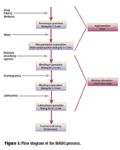
Figure 1
During the agglomeration stage, all or part of the API is mixed with fillers and a granulating binder to obtain a uniform mixture. During mixing, a small amount of water (1–4% of the weight of the entire formula) is sprayed onto the powder blend, thus enabling the water droplets to moisten the binder to make it moist and tacky. The API and excipient particles bind together as the mixer impellers or blades move them in a circular motion. The resulting agglomerates are small, spherelike granules with a typical particle size of 150–500 μm.
In the next stage of the process, moisture absorbents such as microcrystalline cellulose or silicon dioxide are added while mixing continues. The entire mixture becomes drier as some of the water in the moist agglomerates is released to the moisture absorbents. The agglomerates remain largely intact during the moisture-distribution stage, although the larger particles often break up. Disintegrant is added to the mixture at this stage and blended. Then, while mixing continues, lubricant is added and blended for sufficient time to achieve adequate lubricity. This completes the MADG granulation process, which takes about 15 min.
Batch manufacturing. Table I shows a typical MADG formulation, designated as Formulation G. In this formulation, lactose monohydrate, representing 65.0% (w/w) of the formula, is a surrogate for the API. The amount of lactose monohydrate maybe reduced to accommodate the drug load. Iron oxide (red) is used to demonstrate the mixing uniformity of the formulation. PVP K-12 is the granulating binder, and water is the granulating liquid. Micro crystalline cellulose (Avicel PH200 LM) and silicon dioxide (Aeroperl 300) are used as fillers and moisture absorbents, respectively. Crospovidone and magnesium stearate are added as a disintegrant and a lubricant, respectively.
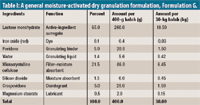
Table I: A general moisture-activated dry granulation formulation, Formulation G.
The ingredients for Formulation G,in the amounts listed in Table I were used to manufacture a 400-g batch using a Diosna 2 L granulator. Lactose monohydrate, PVP K-12, and iron oxide were premixed in the granulator for 1 min. at an impeller speed of 400 rpm (tip speed 3.7 m/s) and a chopper speed of 1200 rpm. Keeping the same mixing conditions, 5.6 g of water was sprayed onto the powder bed at a rate of 10 g/min using a Schlick spray nozzle with a 0.15-mm diameter orifice. Water-droplet size (d90) was ~110 μm during the spraying. Mixing was continued at the same conditions for an additional 3 min to form the moist agglomerates. With continual mixing, microcrystalline cellulose was added into the granulator and mixed for 3 min. Silicon dioxide was next added and mixed for 3 min, followed by crospovidone for an additional mixing of 2 min. Then, with the impeller speed reduced to 200 rpm and the chopper turned off, magnesium stearate was added into the granulator and mixed for 30 s. This final blend was compressed into pellets (500-mg weights), using a Carver press with a set of 7/16-in. round, flat-faced tooling. The compression force was 4000 lb with dwell time of no more than 1 s. The pellet-ejection force was measured using an in-house device. The average pellet-ejection force and hardness of three replicate measurements were reported.

Table II: Compositions of Formulations G, G7, and G9.
Additional batches based on Formulation G were manufactured at a 400-g batch size to evaluate the effects of critical formulation and process variables in the MADG process. Table II lists Formulations G, G7, and G9 made with the granulating binder, PVP K-12, at levels of 5.0%, 7.0%, and 9.0%, respectively. Table III lists Formulations G, G200, and G60 made with water-droplet sizes (d90) of 110 μm, 200 μm, and 60 μm, respectively, while maintaining PVP K-12 level the same at 5.0%. Table IV lists Formulations G, GH, GC, and GM made with different granulating binders (i.e., PVP K-12, HPC EXF, copovidone, and Maltrin 180, respectively).
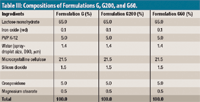
Table III: Compositions of Formulations G, G200, and G60.
Formulation G7 was manufactured three times at the 400-g batch scale to evaluate the reproducibility of the MADG process. Formulation G was also manufactured at a 30-kg batch size to evaluate the process scalability using an Aeromatic-Fielder PMA 150 L high-shear granulator (see Table I). While keeping all other manufacturing process parameters the same as those used for the 400-g batch, premixing and agglomeration were carried out with impeller and chopper speeds of 95 rpm (3.7 m/s) and 1700 rpm, respectively. Water was sprayed onto the powder bed at a rate of 120 g/min using a Schlick spray nozzle with a 0.4-mm diameter orifice.
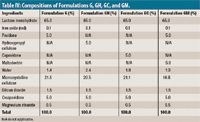
Table IV: Compositions of Formulations G, GH, GC, and GM.
The wide applicability of the MADG process was evaluated by replacing lactose monohydrate in Formulation G with other materials. Table V lists Formulations G, M, and A, in which the main ingredient is lactose monohydrate, mannitol, or acetaminophen. Each product was manufactured following the same procedure as that used for Formulation G at the 400-g scale.
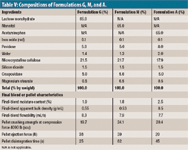
Table V: Compositions of Formulations G, M, and A.
MADG process-based tablet formulations were also developed for compounds A, B, C, and D. Table VI lists Formulations CA, CB, CC, and CD made with compounds A, B, C, and D, respectively. Each product was manufactured using the same procedure as that used for the Formulation G at the 400 g scale.
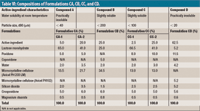
Table VI: Compositions of Formulations CA, CB, CC, and CD.
Image acquisition. Powder and granule images were acquired during batch manufacture using a SMZ1500 stereoscopic zoom microscope system (Nikon, Tokyo).
Water-droplet size measurement. The water-droplet size was measured with a SprayWatch imaging system (OSEIR, Tempere, Finland) (5). The system uses a charged-coupled device camera with microscope lens and a diode laser light source to measure the droplet size and velocity distribution. More than a thousand droplets were typically recorded in each image. The size distribution and its average were derived from the circumference of the enhanced droplet images.
Particle-size analysis. An ATM sonic sifter (Sepor, Wilmington, CA), equipped with #30, #60, #100, and #200 mesh sieves and pan, was used for powder particle-size analysis. The sieves were sequentially stacked with the #30 sieve on the top and the #200 sieve at the bottom on top of the pan. About 10.0 g of sample were placed on the #30 mesh screen to begin the test. The sieve-and-pan assembly was vibrated for 5 min at an amplitude level of 4–5 and a pulsing interval of 5 s. The powder or granules of various particle-size ranges was then separated and remained on each of the screens and pan. The weight of the powder or granules retained on each sieve and in the pan was used to determine the particle-size distribution of the powder.
Apparent bulk density. A Scott volumeter (Prabha Engineering Products, Delhi, India) was used to determine the apparent bulk density of powders. The weight of the powder required to fill a 1-in.3 container in a loose but reproducible manner was measured. The average of three replicate measurements was reported.
Powder flowability. An Erweka GT flow tester (Erweka USA, Flemington, NJ) was used to determine flowability of the powders. About 25–50 g of sample were placed in a 200-mL funnel and tested with the setting at agitation Level 1 for each measurement. The length of time required for the entire sample to flow through the funnel was measured. The average of three replicate measurements was reported.
Pellet hardness. A Key tablet hardness (Key International Englishtown, NJ) tester was used to determine pellet hardness. The average of three replicate measurements was reported.
Moisture content. A Mettler Toledo HR73 halogen moisture analyzer (Mettler-Toledo International Columbus, OH) was used to measure the loss-on-drying of the powders. Approximately 2 g of sample was kept at 85.0 °C and repeatedly weighed for loss of moisture until a constant weight was achieved. The average of three replicate measurements was reported.

Figure 2
Results
Characterization of Formulation G. The granulation particle-size progression of Formulation G during the MADG process at 400-g scale is shown in Figure 2. Figure 2a is the image of the premix of lactose monohydrate, iron oxide, and PVP K-12. This dry blend has many fine particles. Figure 2b shows the image of the granules formed during the agglomeration stage as a result of the addition and mixing with water. The fine particles in the premix have bound together to form spherelike agglomerates with a particle-size range of 150–500 μm. These agglomerates are moist at this stage. The granule particle-size enlargement progression was obvious from the premix (Figure 2a) stage to the end of agglomeration (Figure 2b). Figure 2c shows the image of the granules after mixing with microcrystalline cellulose (Avicel PH200 LM). As can be seen, some agglomerates in Figure 2b have broken up into smaller granules because of the drying effect of Avicel PH200 LM. Some of the moisture in the moist agglomerates is taken up by the drier Avicel PH200 LM, and this moisture redistribution results in the drying of the moist agglomerates. Some breakage of the larger agglomerates also occurs as a result of the drying of the moist agglomerates. As a consequence of some of the larger agglomerates breaking, the granulation particle-size distribution became fairly uniform with few fines. Figure 2d shows the image of the final blend of Formulation G. Unlike in Figure 2c, the smaller particles in Figure 2d essentially came from the crospovidone and magnesium stearate. The silicon-dioxide particles can barely be seen because they are transparent under the light used for microscopic observation.

Figure 3
For the final blend of the same Formulation G batch, the images of the particles retained on #60 (250-μm), #100 (150-μm), and #200 (75-μm) screens, as well as the ones that passed through the #200 screen, are shown in Figure 3. A comparison of the particle-size distribution between the physical mixture and the MADG-processed ingredients of the entire formulation is illustrated in Figure 4. As can be seen, the MADG process reduced the amount of particles smaller than 75 μm (#200 mesh) by 43% and increased the amount of particles between 75 μm (#200 mesh) and ~250 μm (#60 mesh) by 38%. The amount of particles larger than 250 μm (#60 mesh) caused by the MADG process, on the other hand, only increased by ~1%. A comparison of other properties of the physical mixture and the MADG-processed Formulation G is presented in Table VIII. The MADG process significantly improved the granulation flowability. The granulation's apparent bulk density does not change much because the MADG process results in minimal densification, which is an added advantage of the process. Other properties of the batch made with the MADG process (e.g., the final blend moisture content, pellet compaction, and pellet disintegration) were not compromised. The results show that although the MADG process does not create big granules or granule lumps that need size reduction, it reduces fine particles and creates small, uniform, free-flowing, and compactible granulation.

Figure 4
Effect of binder level. The granulating binders play a significant role in agglomeration during the MADG process. The effect of binder levels was studied by using different levels of a binder, PVP K-12, to prepare granulations of Formulation G at 400-g batch size. As shown in Table II, the amount of PVP K-12 in Formulations G, G7, and G9 is 5.0%, 7.0%, and 9.0%, respectively. The change in composition from the amount of binder and water in each formula was offset by the corresponding amount of Avicel PH200 LM. In these experiments, large amounts of binder required more water to hydrate, thus causing a proportional increase in the amount of water with binder content. As shown in Figure 5, the particle-size distribution results of these batches indicate that higher amounts of PVP K-12 and water led to coarser particles in the final blend. The number of particles larger than #30 mesh (600 μm), on the other hand, increased only slightly (i.e., from 0.6% to 1.6%). The results suggest that one can control particle-size enlargement by simply controlling the amount of binder used.
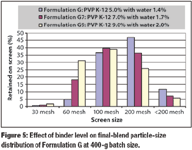
Figure 5
Effect of water-droplet size. Formulation G was used to prepare granulation batches, all at 400-g batch size, with the same amount of water, but delivered in different droplet sizes. This technique allowed the authors to study the impact of water-droplet size on the quality of the formulation. As shown in Table III, the water-droplet size (d90) for Formulations G, G200, and G60 was 110 μm, 200 μm, and 60 μm, respectively. The particle-size distribution of the final blend of each batch is shown in Figure 6 and the results indicate that the percentage of the coarse particles retained on #30 and #60 mesh screens increased when the water-droplet size was larger. However, the final blend particle-size distribution was not much different when the water-droplet size was below 110 μm. It can be deduced from these results that, although it is important to spray water onto the powder bed as uniformly as possible, the MADG process appears to allow some flexibility with respect to the range of water-droplet size that can be used.

Figure 6
Process reproducibility and scalability. The manufacture of Formulation G7 at 400-g scale was repeated three times using a Diosna 2 L high-shear granulator to evaluate the reproducibility of the MADG process (see Table II). As shown in Figure 7, the results suggest that the MADG process was consistent and reproducible for this formulation in terms of its ability to create comparable particle-size distribution in the final blend.

Figure 7
Formulation G was scaled up to a 30-kg batch size in an Aeromatic-Field PMA 150 L high-shear granulator (see Table I). Figure 8 compares the particle-size distribution of the final blend of the 30-kg batch and that obtained with the 400-g batch using a Diosna 2 L high-shear granulator. The results indicate that the scale-up batch had similar final blend and pellet physical properties to those of the smaller batch (see Table VIII). These results imply that, despite the differences in the two granulators, the MADG process is able to produce a consistent product profile even after a 75-fold scale up of the formulation.
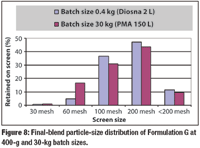
Figure 8
Effect of different binders. Formulation G was used to prepare granulation batches with different types of granulating binder. The effect of different binders was studied by using the same amounts of different binders to prepare the granulation of Formulation G at 400-g batch size. As shown in Table IV, PVP K-12, HPC EXF, copovidone, and Maltrin 180 were used in Formulations G, GH, and GC, and GM, respectively. During the preliminary studies, each binder required a slightly different amount of water to hydrate. Therefore, the amount of water used for each binder in each formulation was adjusted to provide approximately similar hydration effects. Figure 9 shows the granule images at the end of the agglomeration stage for each batch. Among the binders, PVP K-12 appears to be better for this process, and HPC EXF does not appear to be as efficient (see Figures 9a and 9b). Figure 10 shows the final blend particle-size distribution with the different binders. The particle-size distribution results are consistent with the images of the wet agglomerates, indicating that the final blend made with HPC EXF has more fines than others (see Figures 9 and 10). However, the final blend using HPC EXF as a granulating binder was still a free-flowing granulation. These results suggest that different granulating binders can be used successfully in the MADG process to develop granulations with satisfactory properties.
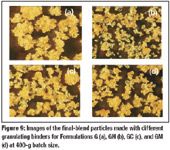
Figure 9
Process applicability. The MADG process is suitable for making solid dosage forms in which various APIs with a wide range of physicochemical properties and drug-loading requirements can be accommodated. Table V shows three formulations in which the main ingredient was lactose monohydrate, mannitol, or acetaminophen. The particle-size distribution of the three final blends is also shown in Figure 11. These results demonstrate that, with proper adjustment of the binder and water levels, all three formulations produced granulations of essentially similar product characteristics such as final-blend moisture content, apparent bulk density, and flowability. The pellets of these three formulations have similar properties such as pellet ejection force, crushing strength, and disintegration time as well.
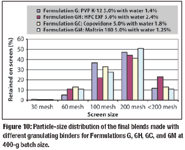
Figure 10
Table VI shows the formulation compositions of various compounds that differ with respect to solubility, particle size, and drug-loading requirements. As shown in Table VI, compounds A, B, C, and D were developed into Formulations CA, CB, CC, and CD, respectively. All of these formulations achieved satisfactory final blend and tablet-quality attributes using the MADG process. For compound B, copovidone was used as the granulating binder for reasons of product chemical stability. For compound D, which was a micronized, less wettable, and fluffy material, 70.5% of the API (45.8% of the entire formula) was included in the agglomeration stage, and the remaining 29.5% (19.2% of the entire formula) was added in the moisture absorption and redistribution stage. Because this compound appeared more difficult to moisten and granulate during agglomeration, larger amounts of PVP K-12 (11.5%) and water (4.2%) were used in the formulation. As a result, more Aeroperl 300 (5.2%) and less Avicel PH102 (5.2%) were used, compared with the other formulations. Formulation CD demonstrated that although Avicel PH200 LM can make it easier to develop an MADG formulation, it is not required.
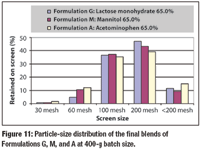
Figure 11
An acceptable granulation process must provide satisfactory content uniformity of dose. In general, the lower the drug loading in the formulation, the greater the challenges of the drug-content uniformity in the final granulation. Taking Compound C as an example, the API-content uniformity in the tablets was analyzed using a validated high-performance liquid chromatography method. Table VII shows that the drug loadings of Formulation CC were 2.5% and 25.0%, and the relative standard deviation values of the API content uniformity of the Compound C tablets were 1.9% and 1.1%, respectivley. According to the acceptance criteria in the "Uniformity of Dosage Units" in the General Chapter <905> of the US Pharmacopeia 31, the results were satisfactory.
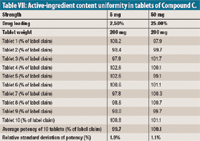
Table VII: Active-ingredient content uniformity in tablets of Compound C.
Advantages of the MADG process
The MADG process makes it possible to do only that which is necessary to produce solid dosage forms with desirable quality attributes. In a sense, it is a minimalist process. The MADG process has many advantages. For example, it creates relatively small granules of narrow particle-size distribution with good flowability. The MADG-based granulations also tend to have good compactibility and weight control during tablet compression. The potential for segregation is eliminated for two main reasons. First, the agglomeration stage constitutes 70–90% of the entire formulation in most cases. Second, the excipients added in the moisture-absorption stage often have a particle size similar to that of the agglomerates. The MADG process is also amenable to scale-up with few or no risks. For example, a large-scale batch typically results in a uniform water distribution, which is desirable and beneficial. The minimalist aspect of the process is manifest in the fact that the process involves few pieces of equipment and manufacturing steps. The net processing time of the MADG process is also short, and no additional requirements for drying, extra material transfer, milling, and separate blending exist. These advantages make the MADG process a good candidate for the application of the US Food and Drug Administration's quality by design (QbD) philosophy. Because the process does not need granulation drying or milling steps, it is a green process that has a great potential to be developed into a continuous process.

Table VIII: Physical properties of Formulation G.
The MADG process has been employed successfully at Bristol-Myers Squibb (New York) to develop tablet formulations for at least 20 new investigational drug compounds. In addition, several existing wet-granulation and roller-compaction tablet formulations have been converted to the MADG process successfully with or without formula changes. The finished products made with the MADG process have had similar or better pro duct-quality attributes than those of the original formulations.
The main drawbacks of the MADG process for solid dosage-form development arise from the use of drug compounds that are water labile and when a large amount of water (i.e., more than 5–10%) is needed for special reasons (e.g., phase transformation) during the granulation process. Product instability results from the use of water-labile drug compounds, and the excessive use of water defeats the fundamental purpose of the MADG process. For these reasons, the authors do not recommend the MADG process if these two situations exist.
Conclusions
The MADG is a simple, clean, lean, and robust process for particle-size enlargement. The results from the evaluation of the effects of the granulating binder level, binder type, water amount, and water-droplet size suggest that the MADG process is robust and creates granulation with good physical properties and finished products with satisfactory quality attributes. The process is applicable to most of the granulation needs for solid dosage-form development as practiced in the pharmaceutical industry. It is essentially a one-pot granulation process. It is also an economical, energy-saving, green, and efficient manufacturing process. The MADG process has advantages such as short manufacturing time and few critical formulation and process variables. These advantages make the MADG process a better candidate than conventional wet- or dry-granulation processes for QbD concepts. Because the MADG process does not require drying or milling, it is suited for use as a continuous process.
Acknowledgements
The authors are grateful to FMC BioPolymer and Evonik Degussa for providing samples of micro crystalline cellulose (Avicel PH200 Low Moisture) and silicon dioxide (Aeroperl 300), respectively.
The authors also sincerely thank their colleagues in the biopharmaceutics research and development department at BMS for their help in executing various experiments and for their constant support and encouragement. In particular, we appreciate Maurice Lobo's and Jeffrey Hemenway's thoughtful comments and tablet-content uniformity data of various compounds.
Ismat Ullah is president of Simple Pharma Solutions (Cranbury, NJ). Jennifer Wang* is a senior research investigator, Shih-Ying Chang is a principal scientist, Hang Guo is a research scientist, San Kiang is a research fellow, and Nemichand B. Jain is director of biopharmaceutics research and development, all at Bristol-Myers Squibb, One Squibb Dr., New Brunswick, NJ 08903, tel. 732.227.5684, jennifer.wang@bms.com
*To whom all correspondence should be addressed.
Submitted: Feb. 23, 2009. Accepted: Apr. 21, 2009.
References
1. I. Ullah et al., Pharm. Technol. 11 (9), 48–54 (1987).
2. C. Chen et al., DrugDev. Ind. Pharm. 16 (3), 379–394 (1990).
3. L.H. Christensen, H.E. Johansen, and T.Schaefer, Drug Dev. Ind. Pharm. 20 (14), 2195–2213 (1994).
4. I. Ullah etal., Pharm. Technol. 33 (11), 62–70 (2009).
5. W. Chen et al., J. Pharm. Innov. 3 (1), 3–14 (2008).

Drug Solutions Podcast: A Closer Look at mRNA in Oncology and Vaccines
April 30th 2024In this episode fo the Drug Solutions Podcast, etherna’s vice-president of Technology and Innovation, Stefaan De Koker, discusses the merits and challenges of using mRNA as the foundation for therapeutics in oncology as well as for vaccines.
Pharmaceutical Tariffs Are Imminent: How Industry is Bracing for Impact
April 16th 2025On April 14, 2025, the Trump Administration launched a national security-driven investigation into pharmaceuticals, a move that will likely result in tariffs being placed on pharmaceutical drugs, ingredients, and other components that are imported from outside of the United States.